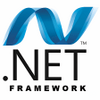Free framework software for Windows 10 allowing the creation of web, desktop, and mobile applications
Free framework software for Windows 10 allowing the creation of web, desktop, and mobile applications
Vote: (137 votes)
Program license: Free
Developer: Microsoft
Version: 4.8.1
Works under: Windows
Vote:
Program license
(137 votes)
Free
Developer
Version
Microsoft
4.8.1
Works under:
Windows
Pros
- Allows users to deploy .NET apps
- Programmers can use .NET as a framework
- Many apps now require .NET, so it could be looked at as a prerequisite
- Hotfixes solve most security-related problems
Cons
- Somewhat bloated
- May not be necessary for all users
- The method for making XOML files has changed over time
The Microsoft .NET framework is a runtime environment and programming platform that allows programs written with certain foundational class libraries to execute on Windows PCs. End users will never have to concern themselves with any of this, since the internals of how the .NET system works isn't usually of particular importance. The reason most people will install the software is simply because they need it.
Engineers sometimes use the .NET framework to quickly develop computer programs by importing libraries filled with precompiled subroutines that handle many common functions. The .NET libraries handle everything from database connectivity to cryptography, which means that coders won't have to manually write routines that handle these tasks. When you download and install a program that expects those libraries to be there, you may get a message that informs you that you don't have the .NET infrastructure installed.
Simply downloading the .NET setup wizard and agreeing to a few prompts will solve this issue. End users can usually forget about the framework the moment that installation is complete. Since Microsoft has promoted .NET technology for the development of most new applications on the Windows platform, the framework can be looked at as a prerequisite for running almost any kind of software.
Those who might have experienced error messages in the past will more than likely never see them again. In most cases, simply installing the .NET framework and its various dependencies is enough to solve any and all of these problems.
Power users might run into a few hiccups, however. XOML file creation is an important aspect of many online frameworks. Over time, .NET has changed the way that this process happens. If you've written programs that use the older paradigm, then you'll need to go into your source code listings and change a few things around before they work again.
While those who aren't programmers are unlikely to run into this kind of issue, they might find that some older software doesn't work as a result of these changes. They might occasionally receive some funky error messages that aren't all that descriptive, which may prove to be extremely confusing.
That being said, a majority of users will never suffer from these problems. In fact, this could be said of an overwhelming majority of runtime environments on the Windows platform. Since PC hardware is always in flux, programmers can't be sure of whether or not their code will execute on a specific machine.
On the other hand, programmers will find a lot to love when it comes to working with the .NET libraries. Since the framework includes user interface controls as an abstraction, you won't have to worry about coding any UI widgets yourself. Engineers can rely on other abstractions to handle numeric calculations as well as communicating with the network stack. The .NET system itself has a relatively massive component stack that provides more than enough middleware to run almost any kind of software.
Working with such a large stack would traditionally cause application software to become extremely bloated, but the .NET interface has solved this problem by loading only those components that are needed at runtime. That makes it run at least somewhat faster than the older frameworks Microsoft phased out in favor of it.
As more and more PCs transition to the ARM platform, users are finding themselves running Windows software inside of an emulator regardless of whether they realize it or not. This is due to the fact that traditional Windows applications are written for the x86 and x86_64 environments while some newer PCs use ARM microchips. Deploying a virtual machine in this environment can slow things down, but it's the only way that Windows can run traditional apps on ARM-based machines.
Fortunately, .NET is lean enough that people shouldn't notice that much of a difference when they run software that relies on it on an ARM machine. Those who have faster RISC-based chips in their computers shouldn't notice much of a difference at all. Best of all, they'll be able to download and install the .NET framework without even realizing anything was amiss.
Pros
- Allows users to deploy .NET apps
- Programmers can use .NET as a framework
- Many apps now require .NET, so it could be looked at as a prerequisite
- Hotfixes solve most security-related problems
Cons
- Somewhat bloated
- May not be necessary for all users
- The method for making XOML files has changed over time




